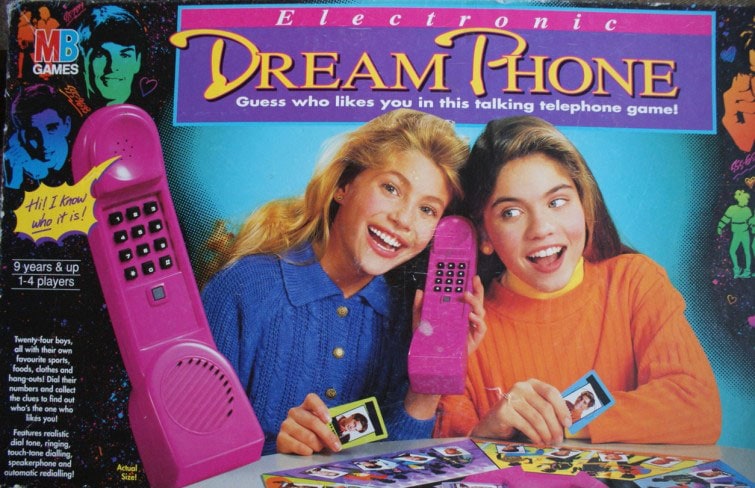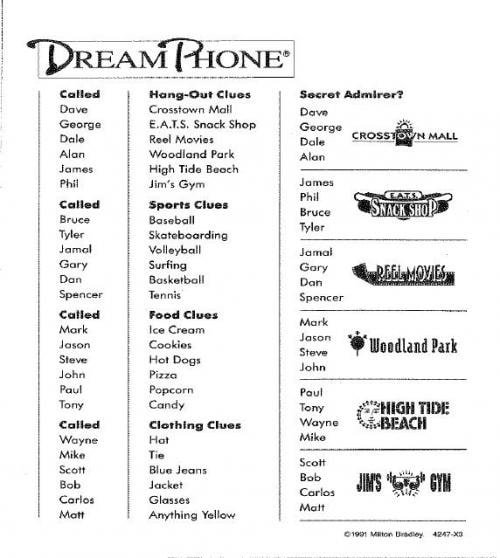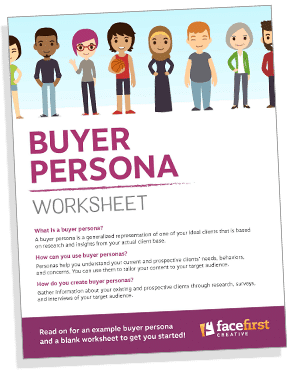Growing up, I played Dream Phone more often than you did and until I was in well into high school. And then on college breaks.
The point of the game, for all of you pretending to not know about it, was to figure out which boy was your secret admirer by a series of phone calls to and from other boys and so-called friends. Each player collected clues regarding his hobbies, frequent hangouts, and favorite foods. (“He’ll eat almost anything! But not popcorn.”
Notes were marked down on the following sheet:
Occasionally, a call would come in and announce, “I know who it is, but I’m not telling. HA HA.” But other than that bullshit, what more could an adolescent* girl ask for than an oversized pink cordless phone transmitting nonstop hunky calls?
Ok, so the point of the game was a little different than marketing, but definitely just as fun. In marketing, it’s important to understand the behaviors and backgrounds of your potential clients before pursuing them. And while you probably don’t need to know where they hang out on Friday nights, knowing which blogs, news sites, etc. they visit regularly can help you infer their motivations.
It’s also helpful to get an idea of their demographics, job responsibilities, challenges, and goals. Rolling all this information into one representation of your ideal customer is called a buyer (or marketing) persona.
What exactly is a buyer persona?
A buyer persona is a generalized representation of your ideal customer based on research and insights you gather from your actual client base. Buyer personas help you understand your existing and prospective clients a little better, and make it easier for you to tailor content to the specific needs, behaviors, and concerns of different groups.
Buyer personas can help you focus your marketing strategy because they give you the knowledge you need to align your marketing decisions with your buyer’s expectations.
How do you create a buyer persona?
Creating a buyer persona is not a difficult process, but takes some time up front. It involves, at a minimum, the following research:
Talk to your team.
Anyone who interacts with your clients or is privy to client data should share their insights. Ask your sales team for feedback on the leads they’re interacting with the most—what generalizations can they make about the different types of clients?
Conduct interviews and surveys.
Set up informal interviews with existing clients, either in person or over the phone. Ask them what about your company keeps them coming back for more. Send surveys to prospects and collect their demographic information.
Stalk ‘em on social media.
Check out Twitter, Facebook, and LinkedIn to find out what your potential customers are interested in, in need of, or complaining about.
Use forms to your advantage.
When creating forms on your site, use fields that capture important persona information, like company size or most commonly used social media accounts.
Once you’ve collected sufficient information, you can create a semi-fictional representation of your ideal customer. The more detailed the better. Hey, if they don’t like popcorn and you’re sure of it, include it. But don’t beat yourself up if you don’t know their innermost thoughts. Certainly their job-related info is the most important—what is their position/title and what are their responsibilities? What are their challenges and goals? Why would they want to work with you?
There are several buyer persona examples out there to help guide you. Below is an example we’ve put together.
Download our Buyer Persona Worksheet!
As if we haven’t given you enough homework, it’s beneficial to create three to five personas to cover multiple situations. And give them names to differentiate them—Marketing Mark, Small Business Samantha, or just Tom.
Once you’ve created your buyer personas, you can deliver the most relevant content to your target market. And, as a result, you’ll attract the most valuable visitors, leads, and customers to your business. If you’re really lucky, maybe one of them will even call you.
*We didn’t yet know the word “tween” in the ‘90s, did we?

















